Verdict
The Sound Blaster X1 is a solid, inexpensive, and versatile DAC from Creative that boasts a clear and detailed performance with whichever headphone it’s partnered with. The Super X-Fi tech is more miss than hit, and the EQ options don’t always have as big an effect on the sound but regardless the X1 delivers a consistent experience.
Pros
- Clear, balanced performance
- Punchy, weighty bass
- Affordable
- Versatile
Cons
- Super X-Fi more miss than hit
- EQ doesn’t always have a pronounced effect on audio
- Better performance available (for more money)
-
Super X-FiUpmixes stereo sound into 3D audio -
CompatibilityWorks with Windows PC, Mac, and PS4, PS5, Nintendo Switch consoles -
Creative appCustomise the performance of the Sound Blaster through an app
Introduction
Creative has had a long presence in the audio market and the Sound Blaster X1 acts as one of its affordable solutions for improving sound quality.
Audio is consumed in various ways, from laptops, tablets, to smartphones, but often we connect our headphones directly to a device, meaning most aren’t aware the sound could be improved with just one small device.
And that is what Creative’s Sound Blaster X1 looks to do, not just for music but for watching movies, taking video calls, and playing games – a jack of all trades at a low-cost price.
Design
- Lightweight
- Onboard buttons
- Good enough construction
The mass of the main casing is light (15g), the first sign of its rather humble asking price, but the construction here is good enough – it’s not overtly plastic or cheap in appearance. It is bigger than the THX Onyx or Earmen Eagle, but that’s because it comes with onboard buttons.
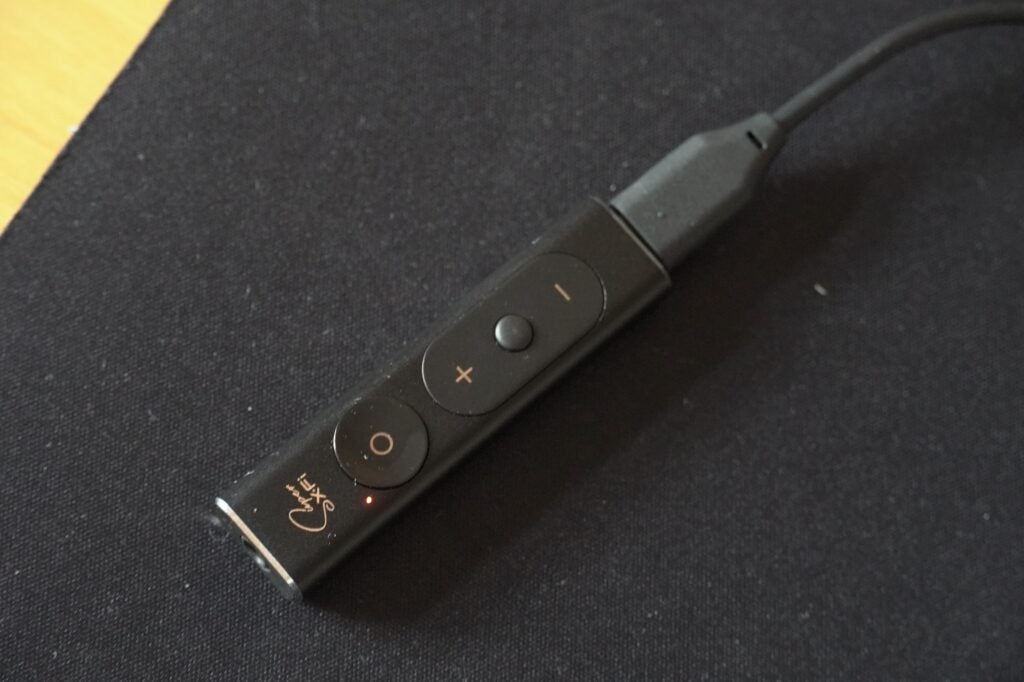
There is a multifunction button (play/pause as well as mute on/off), volume control and activation of the Super X-Fi feature, all of which provide nice, clicky feedback when pressed and I’ve had no compatibility issues using them on Android, iOS, and Windows PC devices.
There’s a nice glossy finish to the Super X-Fi button that also helps in locating it. The lettering on the housing is in gold which gives a nice look against the black background. The silver trim at either end also adds a nice touch. There’s a little LED light next to the X-Fi button that indicates whether X-Fi mode has been activated or not.
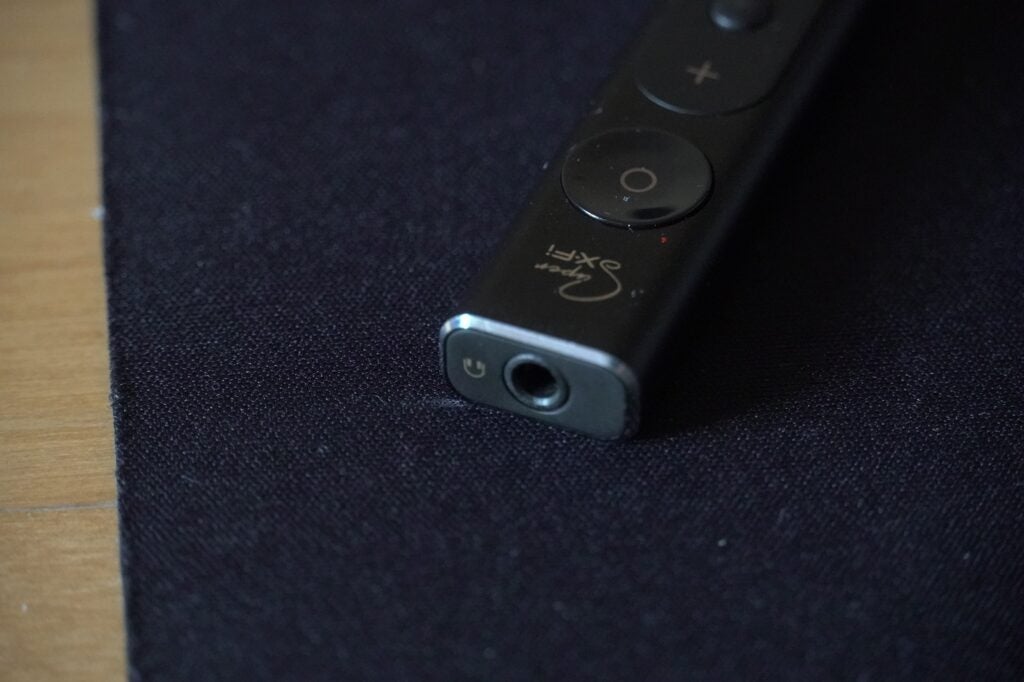
At one end is a USB-C port and at the other is a 3.5mm headphone out. The former is for attaching a USB-C to USB-C cable to connect and power the Sound Blaster X1 and is the only means of connection as there’s no USB-A attachment provided.
Features
- Integrates X-Fi holography technology
- Supports 600ohms headphones
- Two apps: Creative and Super X-Fi
Like a number of Creative’s true wireless and full-sized headphones, the Sound Blaster X1 supports the company’s X-Fi holography technology. This upmixes stereo content into virtualised 3D sound to give the effect of audio appearing around the wearer. It’s supported across PC, Mac, PS4, PS5, and Nintendo Switch, though as far as I can tell the PS4 doesn’t have a USB-C connection…
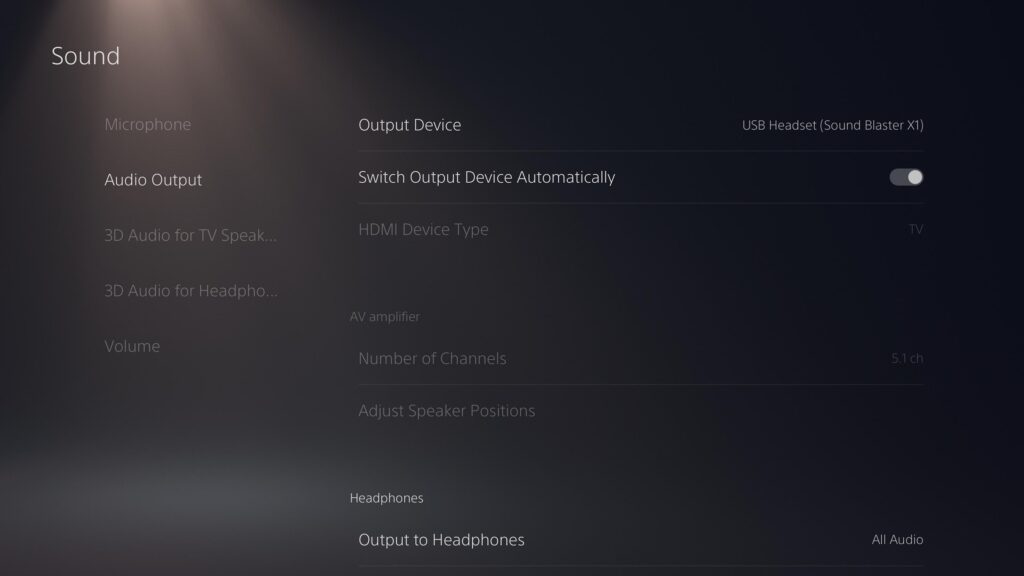
Powering the performance is an AKM 4377 DAC that supports up to 32-bit audio, though the Sound Blaster X1’s max sampling rate hits a ceiling of 24-bit PCM up to 96kHz.
Frequency response is 10 – 20kHz and Creative says the DAC can drive headphones up to 600 ohms. There’s no support for MQA or other hi-res audio formats.
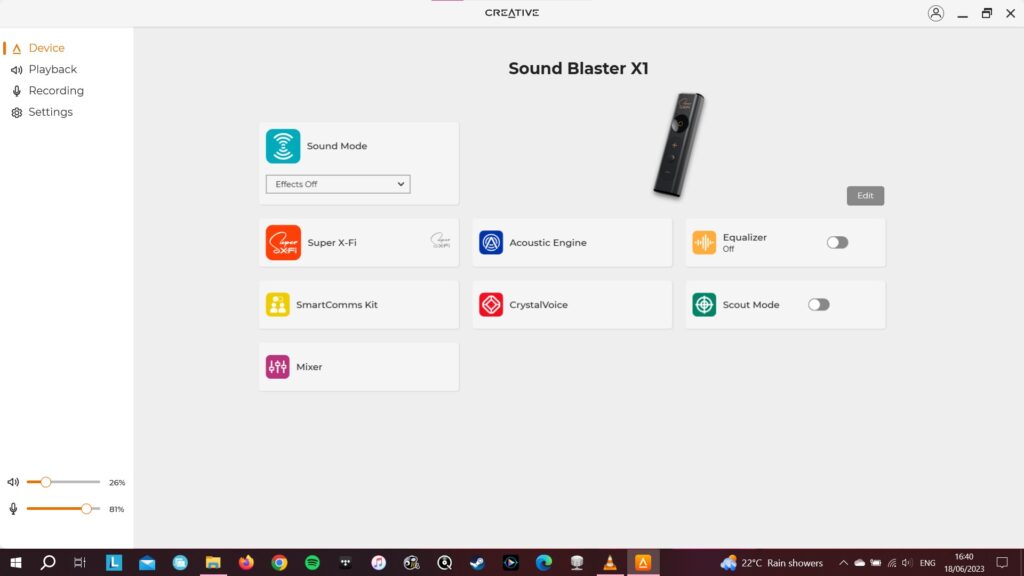
There are two apps, the main one being the Creative app that’s available on PC and Mac. Here is where the performance can be customised. You can switch between different sound modes, including ones built specifically for games such as Fortnite and Overwatch, as well as music and movie EQ settings.
The Acoustic Engine feature is essentially enhancements by another name, offering a choice on whether to focus on voice, increase or decrease the bass, improve vocal clarity, and enhance virtual surround sound, of which the Sound Blaster X1 claims to be able to create up to 7.1 channels.
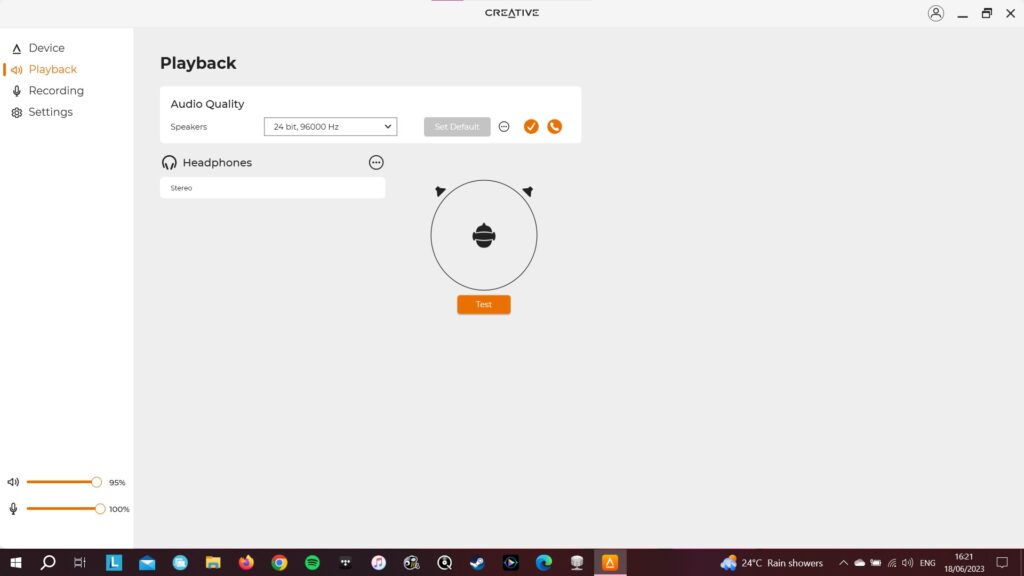
Crystal Voice aims to enhance the clarity of calls with its two-way noise-cancellation that removes unwanted noise, though this feature is only for Windows PC and Mac. Scout Mode is a gaming-focused feature that highlights detail so you can hear more of your surroundings, like the footsteps of a player behind you. To me that sounds like cheating.
The other (embedded) app is concerned with the Super X-Fi holographic audio where you can download and mate your listening profile to the Sound Blaster X1.
Sound Quality
- Clear, balanced performance
- Punchy bass
- Spacious soundstage
As far as the benefits of plugging in the Sound Blaster X1, it is a solid but unspectacular performance. If all you’re after is a greater sense of detail and an expanded soundstage, that’s exactly what the Sound Blaster X1 provides.
A listen to the Mrs Coulter track from Alexandre Desplat’s Golden Compass, the Creative treats the tinkly piano notes delicately, the trailing edges of treble notes hang in the air, nicely fading away. Shifts in the dynamic range are handled astutely, with a nice weight to the booming string instruments that immediately settles down, the jump between loud and quiet is handled well.
With Lee Scorsbee’s Airship Adventure I find myself wanting to turn the sound up even louder (in a good way). There’s a clean, precise tone to the string instruments, with decent weight provided to the percussion – I could want for a little more depth to the low end of the frequency range, but the balance achieved is good with no one aspect of the frequency range hogging the limelight.
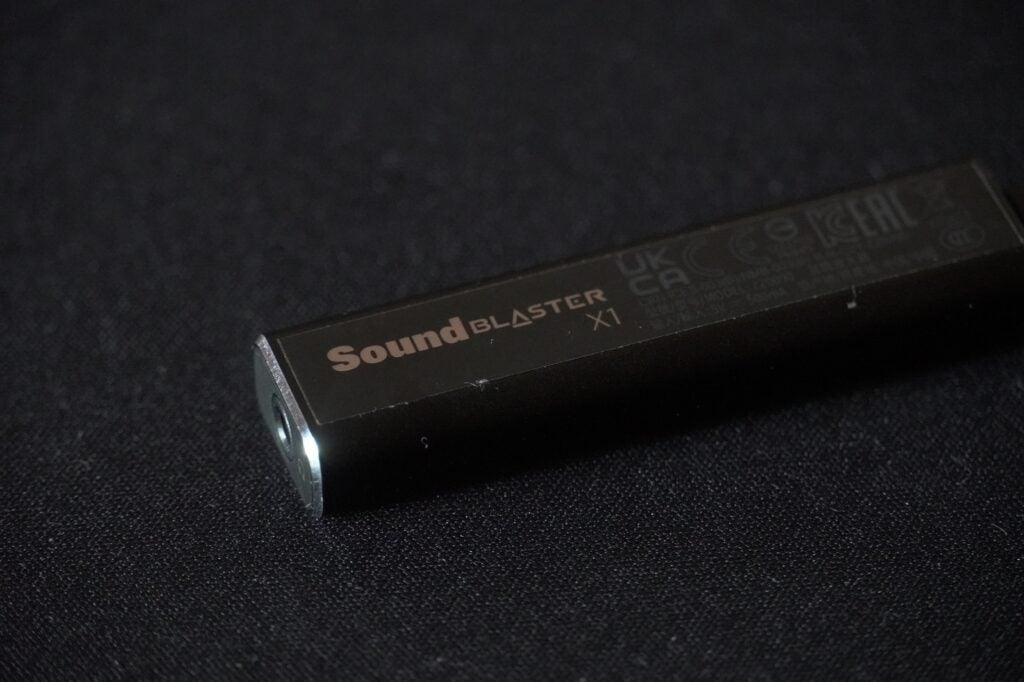
The tone of the Sound Blaster X1’s performance does depend on the headphone it is partnered with. With a Sivga Robin SV021 over-ear it sounded lean, crisp, and quite sparing, especially with the midband of frequency range. A high impedance headphone in the Sivga SV023 (300ohms), and the Sivga asserted its own presence with more warmth to low frequencies, with smoother vocals smoother too; while with a pair of Meze Classic 99, and the sonic signature of the headphones was mostly unruffled.
The Creative Sound Blaster X1 doesn’t seek to transform the soundstage as such, simply to feed music with a finer sense of detail, clarity, and expansion. Beyond that it is not the most adventurous-sounding DAC – it doesn’t attack Detach from Interstellar with much zeal – the Creative seems comfortable with literally amplifying what’s there rather than ‘tampering’ with it.
With Kendrick Lamar’s United in Grief from Mr. Morale & The Big Steppers, the midrange is supplied with good clarity – I can hear every word of Kendrick’s fast-pitched rhymes with clarity – bass is punchily described and never overbearing, while the Sound Blaster X1 preserves a good rhythmic flow with the constant drum beat in the background.
With other tracks from the album – N95 and Die Hard – there’s more body to the bass but the tight and taut sense of punchiness remains, with the bass adding to the energy levels of Die Hard in particular.
Phoebe Bridger’s vocals in the Stranger in the Alps album are ably elevated above the rest of the instrumentation. The Creative enlarges and extends the size of the soundstage, bringing her vocals closer to the ear and digging out a little more detail from her soft vocal intonations. The small details missed listening through the 3.5mm jack have a greater presence on the Sound Blaster X1.
With an iPad Pro and podcasts at the ready I found the Sound Blaster X1 provides clean and clear performance with vocals, along with decent weight to bass, spacious soundstage, and natural tone. You can expect the same with video content – watching Seinfeld on Netflix and Silo on Apple TV+ (with a good weightiness to the Apple TV logo). It’s consistently clean, clear, and detailed.
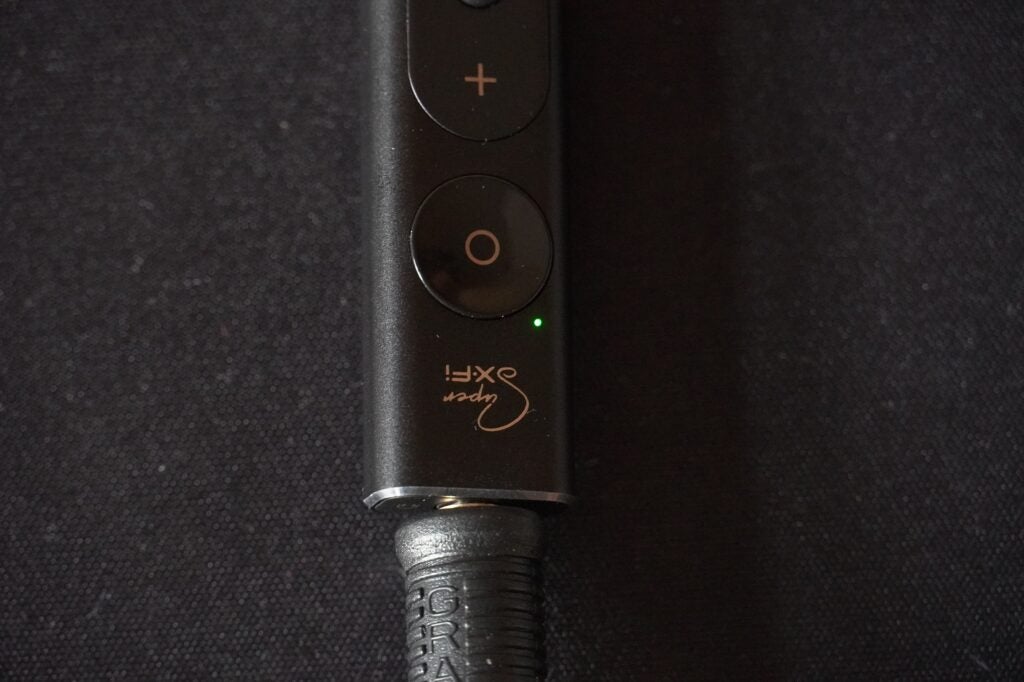
The virtualised 5.1 and 7.1 doesn’t yield the performance I’d have thought, at least with YouTube videos and PC gaming. It is spacious but I can’t decipher much difference in terms of where the sound is coming from or positioned.
Switching to Super X-Fi, there’s a larger sense of distance in relation to foreground and background sounds, and it doesn’t unduly alter the tone of the characters’ voices. I find the bassy register of Common’s voice is a little stripped away though, music is more distant and with bass the part of the frequency range that’s most affected.
Swapping between Super X-Fi and the stereo with music and I prefer the latter over the former. The way X-Fi renders music often sounds artificial and positioned in front of the listener rather than wrapping around, whereas stereo is wider and expansive.
Latest deals
Should you buy it?
To clean up audio at an inexpensive price: The Sound Blaster X1 does a solid job in providing clearer, cleaner, detailed sound.
If you want better performance: It’s half the price of an admittedly higher spec (and music focused) DAC like Earmen Eagle, but the Eagle is a step up in terms of clarity, detail, and sharpness.
Final Thoughts
Who needs a portable DAC? The answer is anyone and everyone who listens to music frequently. Do you need the Creative Sound Blaster X1? If you’re after a DAC that offers a consistent performance at a very affordable price, then possibly.
The amount of customisation it offers is welcome, though I’d question whether some EQ options have that big of an effect. It could also be used as a mic with headphones to clean up audio or for video calls, so it has multiple strings to its bow.
I still find the Super X-Fi more miss than hit but it’s not an essential. The Creative Sound Blaster X1 is a solid, inexpensive DAC for music, movies, gaming, and video calls that’s a step up from an internal DAC of laptops and smartphones.
How we test
We test every DAC we review thoroughly over an extended period of time. We use industry-standard tests to compare features properly. We’ll always tell you what we find. We never, ever, accept money to review a product.
Find out more about how we test in our ethics policy
Tested across several weeks
Tested with multiple sources
FAQs
The Sound Blaster X1 isn’t part of the certification programme Microsoft has for licensed products, so it’s unlikely to work with any Xbox console.
Verdict
The Sound Blaster X1 is a solid, inexpensive, and versatile DAC from Creative that boasts a clear and detailed performance with whichever headphone it’s partnered with. The Super X-Fi tech is more miss than hit, and the EQ options don’t always have as big an effect on the sound but regardless the X1 delivers a consistent experience.
Pros
- Clear, balanced performance
- Punchy, weighty bass
- Affordable
- Versatile
Cons
- Super X-Fi more miss than hit
- EQ doesn’t always have a pronounced effect on audio
- Better performance available (for more money)
-
Super X-FiUpmixes stereo sound into 3D audio -
CompatibilityWorks with Windows PC, Mac, and PS4, PS5, Nintendo Switch consoles -
Creative appCustomise the performance of the Sound Blaster through an app
Introduction
Creative has had a long presence in the audio market and the Sound Blaster X1 acts as one of its affordable solutions for improving sound quality.
Audio is consumed in various ways, from laptops, tablets, to smartphones, but often we connect our headphones directly to a device, meaning most aren’t aware the sound could be improved with just one small device.
And that is what Creative’s Sound Blaster X1 looks to do, not just for music but for watching movies, taking video calls, and playing games – a jack of all trades at a low-cost price.
Design
- Lightweight
- Onboard buttons
- Good enough construction
The mass of the main casing is light (15g), the first sign of its rather humble asking price, but the construction here is good enough – it’s not overtly plastic or cheap in appearance. It is bigger than the THX Onyx or Earmen Eagle, but that’s because it comes with onboard buttons.

There is a multifunction button (play/pause as well as mute on/off), volume control and activation of the Super X-Fi feature, all of which provide nice, clicky feedback when pressed and I’ve had no compatibility issues using them on Android, iOS, and Windows PC devices.
There’s a nice glossy finish to the Super X-Fi button that also helps in locating it. The lettering on the housing is in gold which gives a nice look against the black background. The silver trim at either end also adds a nice touch. There’s a little LED light next to the X-Fi button that indicates whether X-Fi mode has been activated or not.

At one end is a USB-C port and at the other is a 3.5mm headphone out. The former is for attaching a USB-C to USB-C cable to connect and power the Sound Blaster X1 and is the only means of connection as there’s no USB-A attachment provided.
Features
- Integrates X-Fi holography technology
- Supports 600ohms headphones
- Two apps: Creative and Super X-Fi
Like a number of Creative’s true wireless and full-sized headphones, the Sound Blaster X1 supports the company’s X-Fi holography technology. This upmixes stereo content into virtualised 3D sound to give the effect of audio appearing around the wearer. It’s supported across PC, Mac, PS4, PS5, and Nintendo Switch, though as far as I can tell the PS4 doesn’t have a USB-C connection…

Powering the performance is an AKM 4377 DAC that supports up to 32-bit audio, though the Sound Blaster X1’s max sampling rate hits a ceiling of 24-bit PCM up to 96kHz.
Frequency response is 10 – 20kHz and Creative says the DAC can drive headphones up to 600 ohms. There’s no support for MQA or other hi-res audio formats.

There are two apps, the main one being the Creative app that’s available on PC and Mac. Here is where the performance can be customised. You can switch between different sound modes, including ones built specifically for games such as Fortnite and Overwatch, as well as music and movie EQ settings.
The Acoustic Engine feature is essentially enhancements by another name, offering a choice on whether to focus on voice, increase or decrease the bass, improve vocal clarity, and enhance virtual surround sound, of which the Sound Blaster X1 claims to be able to create up to 7.1 channels.

Crystal Voice aims to enhance the clarity of calls with its two-way noise-cancellation that removes unwanted noise, though this feature is only for Windows PC and Mac. Scout Mode is a gaming-focused feature that highlights detail so you can hear more of your surroundings, like the footsteps of a player behind you. To me that sounds like cheating.
The other (embedded) app is concerned with the Super X-Fi holographic audio where you can download and mate your listening profile to the Sound Blaster X1.
Sound Quality
- Clear, balanced performance
- Punchy bass
- Spacious soundstage
As far as the benefits of plugging in the Sound Blaster X1, it is a solid but unspectacular performance. If all you’re after is a greater sense of detail and an expanded soundstage, that’s exactly what the Sound Blaster X1 provides.
A listen to the Mrs Coulter track from Alexandre Desplat’s Golden Compass, the Creative treats the tinkly piano notes delicately, the trailing edges of treble notes hang in the air, nicely fading away. Shifts in the dynamic range are handled astutely, with a nice weight to the booming string instruments that immediately settles down, the jump between loud and quiet is handled well.
With Lee Scorsbee’s Airship Adventure I find myself wanting to turn the sound up even louder (in a good way). There’s a clean, precise tone to the string instruments, with decent weight provided to the percussion – I could want for a little more depth to the low end of the frequency range, but the balance achieved is good with no one aspect of the frequency range hogging the limelight.

The tone of the Sound Blaster X1’s performance does depend on the headphone it is partnered with. With a Sivga Robin SV021 over-ear it sounded lean, crisp, and quite sparing, especially with the midband of frequency range. A high impedance headphone in the Sivga SV023 (300ohms), and the Sivga asserted its own presence with more warmth to low frequencies, with smoother vocals smoother too; while with a pair of Meze Classic 99, and the sonic signature of the headphones was mostly unruffled.
The Creative Sound Blaster X1 doesn’t seek to transform the soundstage as such, simply to feed music with a finer sense of detail, clarity, and expansion. Beyond that it is not the most adventurous-sounding DAC – it doesn’t attack Detach from Interstellar with much zeal – the Creative seems comfortable with literally amplifying what’s there rather than ‘tampering’ with it.
With Kendrick Lamar’s United in Grief from Mr. Morale & The Big Steppers, the midrange is supplied with good clarity – I can hear every word of Kendrick’s fast-pitched rhymes with clarity – bass is punchily described and never overbearing, while the Sound Blaster X1 preserves a good rhythmic flow with the constant drum beat in the background.
With other tracks from the album – N95 and Die Hard – there’s more body to the bass but the tight and taut sense of punchiness remains, with the bass adding to the energy levels of Die Hard in particular.
Phoebe Bridger’s vocals in the Stranger in the Alps album are ably elevated above the rest of the instrumentation. The Creative enlarges and extends the size of the soundstage, bringing her vocals closer to the ear and digging out a little more detail from her soft vocal intonations. The small details missed listening through the 3.5mm jack have a greater presence on the Sound Blaster X1.
With an iPad Pro and podcasts at the ready I found the Sound Blaster X1 provides clean and clear performance with vocals, along with decent weight to bass, spacious soundstage, and natural tone. You can expect the same with video content – watching Seinfeld on Netflix and Silo on Apple TV+ (with a good weightiness to the Apple TV logo). It’s consistently clean, clear, and detailed.

The virtualised 5.1 and 7.1 doesn’t yield the performance I’d have thought, at least with YouTube videos and PC gaming. It is spacious but I can’t decipher much difference in terms of where the sound is coming from or positioned.
Switching to Super X-Fi, there’s a larger sense of distance in relation to foreground and background sounds, and it doesn’t unduly alter the tone of the characters’ voices. I find the bassy register of Common’s voice is a little stripped away though, music is more distant and with bass the part of the frequency range that’s most affected.
Swapping between Super X-Fi and the stereo with music and I prefer the latter over the former. The way X-Fi renders music often sounds artificial and positioned in front of the listener rather than wrapping around, whereas stereo is wider and expansive.
Latest deals
Should you buy it?
To clean up audio at an inexpensive price: The Sound Blaster X1 does a solid job in providing clearer, cleaner, detailed sound.
If you want better performance: It’s half the price of an admittedly higher spec (and music focused) DAC like Earmen Eagle, but the Eagle is a step up in terms of clarity, detail, and sharpness.
Final Thoughts
Who needs a portable DAC? The answer is anyone and everyone who listens to music frequently. Do you need the Creative Sound Blaster X1? If you’re after a DAC that offers a consistent performance at a very affordable price, then possibly.
The amount of customisation it offers is welcome, though I’d question whether some EQ options have that big of an effect. It could also be used as a mic with headphones to clean up audio or for video calls, so it has multiple strings to its bow.
I still find the Super X-Fi more miss than hit but it’s not an essential. The Creative Sound Blaster X1 is a solid, inexpensive DAC for music, movies, gaming, and video calls that’s a step up from an internal DAC of laptops and smartphones.
How we test
We test every DAC we review thoroughly over an extended period of time. We use industry-standard tests to compare features properly. We’ll always tell you what we find. We never, ever, accept money to review a product.
Find out more about how we test in our ethics policy
Tested across several weeks
Tested with multiple sources
FAQs
The Sound Blaster X1 isn’t part of the certification programme Microsoft has for licensed products, so it’s unlikely to work with any Xbox console.
























